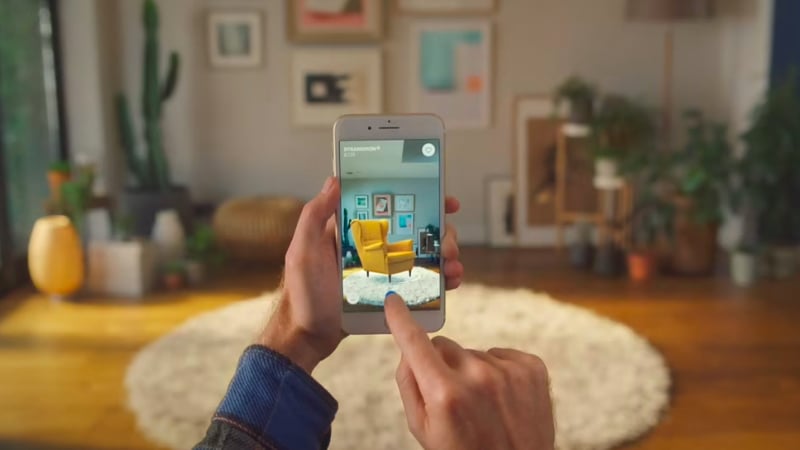Brands that Use Augmented Reality
5 Forward-Looking Furniture Businesses
According to Harvard Business Review, AR has become more than a nice-to-have feature but more of essential technology for manufacturers and retailers. Considering COVID-19 restrictions, it completely makes sense as people weren’t able to visit brick-and-mortar stores for so long. During these times, it was AR that allowed them to try on products in a real environment remotely. But for some reason, many furniture manufacturers and sellers still don’t see it as a must-have. Hence, they get pushed aside by brands that use augmented reality on different levels.
Also, let’s not forget about product returns, one of the main risks of eCommerce. As UPC says, around 27% of shoppers return their purchases because items don’t look as described. And that’s where augmented reality proves useful again — it not only showcases products in detail but allows customers to place AR models in their rooms before purchase. All in all, augmented reality is a safe way for brands to cut goods returns, especially for bulky items like furnishings.
But first of all, what are AR apps, and how the whole augmented reality technology works? In a nutshell, using an AR shopping application, customers can put digital objects in a real-life environment. In the case of furniture shopping, buyers first aim their smartphone or device cameras onto an empty corner of the room and select the furniture piece from the brand catalog. In just a second, they see the product appearing in their interior, right on their screen.
For AR apps to work correctly, brands can’t use regular high-polygonal 3D models because the app engine simply can’t render them correctly. Augmented reality applications and websites work with low-polygonal 3D objects only. So, retailers turn to 3D artists who can optimize high-poly models using the 3D retopology method. By doing so, they reduce the number of polygons and make 3D objects more lightweight. This allows them to be easily processed in real-time.
At CGIFURNITURE, we provide all types of 3D rendering services including 3D modeling for AR applications. So how do brands use augmented reality and how complicated is the whole process of creating 3D objects for AR? We have an answer to that!
#1. IKEA

One of the most famous brands that use augmented reality is IKEA, an AR pioneer and a true giant of the global market. Back in 2017, they introduced their AR app IKEA Place. Using it, consumers could choose any model from the catalog and try it in their interior. Users simply scanned an empty space in their home with a smartphone camera, then browsed the IKEA catalog to find a furniture piece they needed — and an AR item instantly appeared on the screen.
Lately, the brand has gone even further and has launched the beta version of an all-new IKEA Studio app that provides complete home transformation in augmented reality. With this application, users can remodel their entire house using augmented reality tools. IKEA Studio fully recreates the actual rooms in 3D, including windows and doors, walls, and floorings. After scanning is done, customers can re-design their entire home in AR using any materials and textures, and then fill it with IKEA items from top to bottom.
#2. Scanliving
A Danish furniture brand Scanliving makes beds for children and teenagers — from cradles to bunk beds. Their beds are based on a system of blocks that can be added and subtracted according to the age and height of the child. Naturally, buyers would like to be sure that a bunk bed will fit into their children’s room in advance. That’s why Scanliving decided to use AR. And since there are not so many brands that use augmented reality for children’s furnishings on the market, Scanliving’s innovative approach helps parents choose the right model with no worries.
In order to successfully integrate their products into augmented reality, the brand needed models that were compatible with the most popular shopping AR apps. For that, CGIFURNITURE created quality low-resolution AR models and made sure they work for every app on any type of smartphone.
#3. George Chebib
George Chebib is a designer with 20 years of experience who creates custom modern furniture. Lately, the brand switched to CGI for product pictures such as silo renders and lifestyle images. After successful results, they decided to take their interest in the CGI world to the next level.
Being inspired by other brands that have used augmented reality for Shopify, Chebib Furniture also ordered AR models of their products. They asked us to prepare their two furniture pieces for a shopping app — a dining table and a chair. So, our CG specialists took the 3D objects they’ve already created before and optimized them according to Shopify AR requirements.
#4. Clawz
Clawz is a US-based brand that creates cat furniture and currently has three products: Cat Condo, Cat Palace, and Cat Kingdom. All these furniture pieces serve as a playground, a cat gym, and a nest for naps. Clawz needed compelling visuals that could show their products as both functional and fitting into any modern interior.
To bring the Clawz team’s ideas to life, we created 3D models of all three products in several color variations. Then, our 3D artists optimized them until they became low-resolution 3D objects. Now, provided with augmented reality option, customers can digitally “put in” the cat furniture in their homes to find out which Clawz product fits their homes better in style and proportions.
#5. Jofran Inc.
A furniture manufacturer Jofran Inc. is on the market since 1975, and unlike many other companies with a long history, they fully embrace modern CGI technologies. Together, we made more than 30 projects, so the brand got all the CG tools they might need in eCommerce and marketing — silo and lifestyle images, 360° product spins, and AR models.
Based on experiences of other brands that use augmented reality on the market, Jofran Inc. marketers figured out exactly how they want to apply advanced technologies. They asked us to create 3D models that work for both iPhone and Android AR apps. So, we made 3D furniture objects and optimized them using the 3D retopology method. Finally, we saved AR files in usdz. and glb. formats that are compatible with both iOs and Android.
Getting AR models for eCommerce websites and apps is a win-win for both buyers and manufacturers. Customers benefit from it by “trying on” furniture pieces in their homes before actually purchasing them. In turn, brands that use augmented reality, see a reduction in the number of product returns and growth of customer engagement.
Moreover, AR objects are getting more and more affordable. Therefore, not only furniture giants can use augmented reality but also individual designers and small businesses. AR is no longer a technology of the future but a new shopping reality.
Ready to order 3D furniture models for augmented reality for your brand? Contact us for professional 3D rendering services, and get first-rate AR objects that work for any shopping app or site!








Leave a Reply
Want to join the discussion?Feel free to contribute!